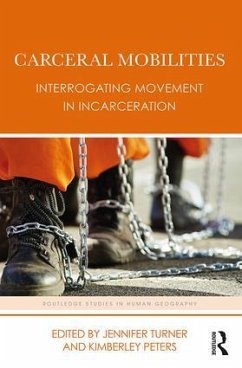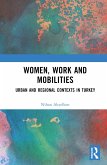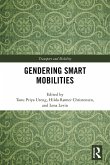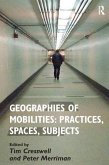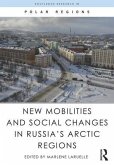Carceral Mobilities
Interrogating Movement in Incarceration
Herausgeber: Turner, Jennifer; Peters, Kimberley
Carceral Mobilities
Interrogating Movement in Incarceration
Herausgeber: Turner, Jennifer; Peters, Kimberley
- Gebundenes Buch
- Merkliste
- Auf die Merkliste
- Bewerten Bewerten
- Teilen
- Produkt teilen
- Produkterinnerung
- Produkterinnerung
This book challenges the assumption that carceral life is characterised by a lack of movement. This book brings together contributions that speak to contemporary debates across carceral studies and mobilities research, offering fresh insights to both areas by identifying and unpicking the manifold mobilities that shape, and are shaped by, carceral regimes. It features five sections that move the reader through the varying typologies of motion underscoring carceral life: tension; transition; circulation; distribution; transposition. Each mobilities-led section seeks to explore the politics encapsulated in specific regimes of carceral movement.…mehr
Andere Kunden interessierten sich auch für
![Carceral Spaces Carceral Spaces]() Nick GillCarceral Spaces216,99 €
Nick GillCarceral Spaces216,99 €![Women, Work and Mobilities Women, Work and Mobilities]() Nihan AkyelkenWomen, Work and Mobilities204,99 €
Nihan AkyelkenWomen, Work and Mobilities204,99 €![Gendering Smart Mobilities Gendering Smart Mobilities]() Gendering Smart Mobilities205,99 €
Gendering Smart Mobilities205,99 €![Geographies of Mobilities Geographies of Mobilities]() Tim CresswellGeographies of Mobilities228,99 €
Tim CresswellGeographies of Mobilities228,99 €![Mobilities and Inequality Mobilities and Inequality]() Hanja MaksimMobilities and Inequality216,99 €
Hanja MaksimMobilities and Inequality216,99 €![New Mobilities and Social Changes in Russia's Arctic Regions New Mobilities and Social Changes in Russia's Arctic Regions]() New Mobilities and Social Changes in Russia's Arctic Regions206,99 €
New Mobilities and Social Changes in Russia's Arctic Regions206,99 €![There and Back again: How young people from Spain perceive mobility There and Back again: How young people from Spain perceive mobility]() Selina HerzogThere and Back again: How young people from Spain perceive mobility44,99 €
Selina HerzogThere and Back again: How young people from Spain perceive mobility44,99 €-
-
-
This book challenges the assumption that carceral life is characterised by a lack of movement. This book brings together contributions that speak to contemporary debates across carceral studies and mobilities research, offering fresh insights to both areas by identifying and unpicking the manifold mobilities that shape, and are shaped by, carceral regimes. It features five sections that move the reader through the varying typologies of motion underscoring carceral life: tension; transition; circulation; distribution; transposition. Each mobilities-led section seeks to explore the politics encapsulated in specific regimes of carceral movement.
Hinweis: Dieser Artikel kann nur an eine deutsche Lieferadresse ausgeliefert werden.
Hinweis: Dieser Artikel kann nur an eine deutsche Lieferadresse ausgeliefert werden.
Produktdetails
- Produktdetails
- Verlag: Routledge
- Seitenzahl: 282
- Erscheinungstermin: 13. Dezember 2016
- Englisch
- Abmessung: 240mm x 161mm x 20mm
- Gewicht: 590g
- ISBN-13: 9781138184046
- ISBN-10: 1138184047
- Artikelnr.: 47330508
- Herstellerkennzeichnung
- Libri GmbH
- Europaallee 1
- 36244 Bad Hersfeld
- gpsr@libri.de
- Verlag: Routledge
- Seitenzahl: 282
- Erscheinungstermin: 13. Dezember 2016
- Englisch
- Abmessung: 240mm x 161mm x 20mm
- Gewicht: 590g
- ISBN-13: 9781138184046
- ISBN-10: 1138184047
- Artikelnr.: 47330508
- Herstellerkennzeichnung
- Libri GmbH
- Europaallee 1
- 36244 Bad Hersfeld
- gpsr@libri.de
Jennifer Turner is a Lecturer in Human Geography at the University of Liverpool, UK. Her research is concerned with spaces, practices, and representations of incarceration, past and present. Jennifer has published widely in the fields of carceral geography and criminology. She is the author of The Prison Boundary: Between Society and Carceral Space (2016). Kimberley Peters is a Lecturer in Human Geography at the University of Liverpool, UK. Kimberley's research analyses the governance of mobilities at sea. Most recently she has pursued this interest through interrogating the politics of mobilities aboard the prison ship (with Jennifer Turner) and via a study of the formulation of maritime regulatory apparatus (funded by the Leverhulme Trust).
Foreword
[Dominique Moran]
1. Carceral mobilities: A manifesto for mobilities, an agenda for carceral
studies
[Kimberley Peters and Jennifer Turner]
Part I: Tension
2. Mobile carceral logics: Aboriginal communities and asylum seekers facing
enclosure in Australia's Northern Territory
[Kate Coddington]
3. The ambivalent camp: Mobility and excess in a quasi-carceral Italian
asylum seekers hospitality centre
[Roberta Altin and Claudio Minca]
4. 'Unruly mobilities' in the tracking of young offenders and criminality:
Understanding diversionary programs as carceral space
[Elaine Fishwick and Michael Wearing]
5. Accommodation for asylum seekers and "tolerance" in Romania: Governing
foreigners by mobility?
[Bénédicte Michalon]
Part II: Circulation
6. Doing time differently: Imaginative mobilities to/from inmates'
inner/outer spaces
[James Gacek]
7. Spreading the word: The dissemination of the American convict code,
1919-1940
[Alex Tepperman]
8. Mobility and materialisation of the carceral: examining immigration and
immigration detention
[Deirdre Conlon and Nancy Hiemstra]
9. On 'floaters': Constrained locomotion and complex micro-scale mobilities
of objects in carceral environments
[Anna Schliehe]
Part III: Distribution
10. Virtual presence as a challenge to immobility: Examining the potential
of an online anti-detention campaign
[Emma Marshall, Patricia Pinkowska and Nick Gill]
11. Mobile authority: Prosecutorial spaces in the Parisian Banlieue
[Joaquín Villanueva]
12. The other side of mobilities: Aboriginal containment in Australia from
rail to jail, past and present
[Katie Maher]
13. The world of the 'rondines': Trust, waiting and time in a Latin
American prison
[Lirio Gutiérrez Rivera]
Part IV: Transition
14. Enforced social mobilisation of 'deviant' women: Carceral regimes of
discipline in Liverpool Female Penitentiary, 1809-1921
[Kirsty Greenwood]
15. Mobilising carceral reformation: Mobility, the will to change, and the
urban history of the juvenile court
[Elizabeth Brown]
16. Carceral transitions experienced through Community Service placements
in charity shops
[Avril Maddrell]
17. Prison: Legitimacy through mobility?
[Christophe Mincke]
Afterword
[Peter Merriman]
[Dominique Moran]
1. Carceral mobilities: A manifesto for mobilities, an agenda for carceral
studies
[Kimberley Peters and Jennifer Turner]
Part I: Tension
2. Mobile carceral logics: Aboriginal communities and asylum seekers facing
enclosure in Australia's Northern Territory
[Kate Coddington]
3. The ambivalent camp: Mobility and excess in a quasi-carceral Italian
asylum seekers hospitality centre
[Roberta Altin and Claudio Minca]
4. 'Unruly mobilities' in the tracking of young offenders and criminality:
Understanding diversionary programs as carceral space
[Elaine Fishwick and Michael Wearing]
5. Accommodation for asylum seekers and "tolerance" in Romania: Governing
foreigners by mobility?
[Bénédicte Michalon]
Part II: Circulation
6. Doing time differently: Imaginative mobilities to/from inmates'
inner/outer spaces
[James Gacek]
7. Spreading the word: The dissemination of the American convict code,
1919-1940
[Alex Tepperman]
8. Mobility and materialisation of the carceral: examining immigration and
immigration detention
[Deirdre Conlon and Nancy Hiemstra]
9. On 'floaters': Constrained locomotion and complex micro-scale mobilities
of objects in carceral environments
[Anna Schliehe]
Part III: Distribution
10. Virtual presence as a challenge to immobility: Examining the potential
of an online anti-detention campaign
[Emma Marshall, Patricia Pinkowska and Nick Gill]
11. Mobile authority: Prosecutorial spaces in the Parisian Banlieue
[Joaquín Villanueva]
12. The other side of mobilities: Aboriginal containment in Australia from
rail to jail, past and present
[Katie Maher]
13. The world of the 'rondines': Trust, waiting and time in a Latin
American prison
[Lirio Gutiérrez Rivera]
Part IV: Transition
14. Enforced social mobilisation of 'deviant' women: Carceral regimes of
discipline in Liverpool Female Penitentiary, 1809-1921
[Kirsty Greenwood]
15. Mobilising carceral reformation: Mobility, the will to change, and the
urban history of the juvenile court
[Elizabeth Brown]
16. Carceral transitions experienced through Community Service placements
in charity shops
[Avril Maddrell]
17. Prison: Legitimacy through mobility?
[Christophe Mincke]
Afterword
[Peter Merriman]
Foreword
[Dominique Moran]
1. Carceral mobilities: A manifesto for mobilities, an agenda for carceral
studies
[Kimberley Peters and Jennifer Turner]
Part I: Tension
2. Mobile carceral logics: Aboriginal communities and asylum seekers facing
enclosure in Australia's Northern Territory
[Kate Coddington]
3. The ambivalent camp: Mobility and excess in a quasi-carceral Italian
asylum seekers hospitality centre
[Roberta Altin and Claudio Minca]
4. 'Unruly mobilities' in the tracking of young offenders and criminality:
Understanding diversionary programs as carceral space
[Elaine Fishwick and Michael Wearing]
5. Accommodation for asylum seekers and "tolerance" in Romania: Governing
foreigners by mobility?
[Bénédicte Michalon]
Part II: Circulation
6. Doing time differently: Imaginative mobilities to/from inmates'
inner/outer spaces
[James Gacek]
7. Spreading the word: The dissemination of the American convict code,
1919-1940
[Alex Tepperman]
8. Mobility and materialisation of the carceral: examining immigration and
immigration detention
[Deirdre Conlon and Nancy Hiemstra]
9. On 'floaters': Constrained locomotion and complex micro-scale mobilities
of objects in carceral environments
[Anna Schliehe]
Part III: Distribution
10. Virtual presence as a challenge to immobility: Examining the potential
of an online anti-detention campaign
[Emma Marshall, Patricia Pinkowska and Nick Gill]
11. Mobile authority: Prosecutorial spaces in the Parisian Banlieue
[Joaquín Villanueva]
12. The other side of mobilities: Aboriginal containment in Australia from
rail to jail, past and present
[Katie Maher]
13. The world of the 'rondines': Trust, waiting and time in a Latin
American prison
[Lirio Gutiérrez Rivera]
Part IV: Transition
14. Enforced social mobilisation of 'deviant' women: Carceral regimes of
discipline in Liverpool Female Penitentiary, 1809-1921
[Kirsty Greenwood]
15. Mobilising carceral reformation: Mobility, the will to change, and the
urban history of the juvenile court
[Elizabeth Brown]
16. Carceral transitions experienced through Community Service placements
in charity shops
[Avril Maddrell]
17. Prison: Legitimacy through mobility?
[Christophe Mincke]
Afterword
[Peter Merriman]
[Dominique Moran]
1. Carceral mobilities: A manifesto for mobilities, an agenda for carceral
studies
[Kimberley Peters and Jennifer Turner]
Part I: Tension
2. Mobile carceral logics: Aboriginal communities and asylum seekers facing
enclosure in Australia's Northern Territory
[Kate Coddington]
3. The ambivalent camp: Mobility and excess in a quasi-carceral Italian
asylum seekers hospitality centre
[Roberta Altin and Claudio Minca]
4. 'Unruly mobilities' in the tracking of young offenders and criminality:
Understanding diversionary programs as carceral space
[Elaine Fishwick and Michael Wearing]
5. Accommodation for asylum seekers and "tolerance" in Romania: Governing
foreigners by mobility?
[Bénédicte Michalon]
Part II: Circulation
6. Doing time differently: Imaginative mobilities to/from inmates'
inner/outer spaces
[James Gacek]
7. Spreading the word: The dissemination of the American convict code,
1919-1940
[Alex Tepperman]
8. Mobility and materialisation of the carceral: examining immigration and
immigration detention
[Deirdre Conlon and Nancy Hiemstra]
9. On 'floaters': Constrained locomotion and complex micro-scale mobilities
of objects in carceral environments
[Anna Schliehe]
Part III: Distribution
10. Virtual presence as a challenge to immobility: Examining the potential
of an online anti-detention campaign
[Emma Marshall, Patricia Pinkowska and Nick Gill]
11. Mobile authority: Prosecutorial spaces in the Parisian Banlieue
[Joaquín Villanueva]
12. The other side of mobilities: Aboriginal containment in Australia from
rail to jail, past and present
[Katie Maher]
13. The world of the 'rondines': Trust, waiting and time in a Latin
American prison
[Lirio Gutiérrez Rivera]
Part IV: Transition
14. Enforced social mobilisation of 'deviant' women: Carceral regimes of
discipline in Liverpool Female Penitentiary, 1809-1921
[Kirsty Greenwood]
15. Mobilising carceral reformation: Mobility, the will to change, and the
urban history of the juvenile court
[Elizabeth Brown]
16. Carceral transitions experienced through Community Service placements
in charity shops
[Avril Maddrell]
17. Prison: Legitimacy through mobility?
[Christophe Mincke]
Afterword
[Peter Merriman]

